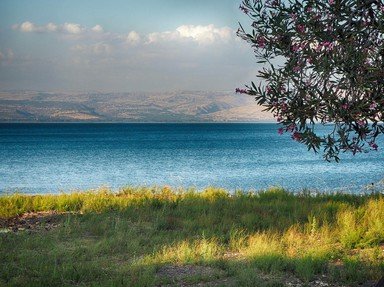Quiz Answer Key and Fun Facts
1. You land at Tyre with a load of wine and pottery from Greece. After selling these you reinvest in luxury goods for Caesarea and Tiberias: purple fabrics, fine linen and embroidery, all from Damascus in Syria. Your planned route is Tyre - Caesarea - Nazareth - Tiberias. You intend to hire a camel train, which can do up to 20 miles per day. How long (in travel time, not counting trading stops) will this journey take you?
2. You have to travel from Caesarea, via Nazareth, to Tiberias. What river, which flows more or less west into the Mediterranean, will you have to cross in the Valley of Jezreel? (This was also the setting of the battle against King Jabin of the Canaanites and Sisera his general, which was led by Deborah and Barak, as recorded in Judges).
3. As a merchant just arrived in Tiberias, a newly built and carefully planned Roman city, where will you most likely set up your shop?
4. In Tiberias you, a Jewish merchant, acquire a load of camphor balm and dried fish, which you plan to sell in Jerusalem. You plan to take the main Roman road south, via Nazareth and Sychar. With a lighter load this time, you will hire a train of pack donkeys, which can travel about 15 miles per day. Given that it is Friday today, and that Jerusalem is about 75 miles away, on what day next week do you expect to reach Jerusalem?
5. Having spent two days resting in Jerusalem, you plan to take a short side trip down to Jericho to see whether you can pick up some bargains in amber and bronze ware. What special precaution might you need to take for this trip (bearing in mind the parable Jesus told in Luke 10:29-37)?
6. You found some great bargains in amber jewelery and bronze vases in Jericho, down in the valley of the Jordan which flows into the Dead Sea. Now you have to transport them all the way back up to Jerusalem, which lies at an altitude of around 2500 feet above sea level. What is the closest estimate of how high you will have to climb from Jericho to Jerusalem?
7. From Jerusalem you are heading south and west, towards Gaza on the main route from Egypt. You hope to get some good deals in gold and gemstones, which travel this way from mines in Africa. This time you have no goods to transport, so you decide to save money and walk. How long will it take you to walk to Gaza, a distance of about 45 miles?
8. In Gaza you find you need to consider a sea voyage north back to Tyre. The weather and winds are favourable, so a cargo ship might do 4.5 knots - call it 5 miles per hour. Sailing during daylight hours only, how many days should the voyage take from Gaza to Tyre?
9. From Gaza you decide instead to return to Jerusalem, but via Beersheba, where you will look for top quality fleeces. Since you will have to move cross-country, through the desert, you will need a camel train and a company of guards. In total you have 20 camels and 10 people for this trip. You expect the first stage of the journey, from Gaza to Beersheba, to take at least two days. Camels are famous for their endurance without water, but in fact no one would ordinarily require their camels to do this without very good reason: like most animals, they would lose condition rapidly, and would only recover very slowly afterwards. As a guide for those who are unfamiliar with animal husbandry, a dairy cow might need, say, 150 litres of water per day. It is high summer, and very hot, and the camels will be heavily laden. How much water should you carry with you?
10. From Beersheba you plan to travel to Hebron. What kind of slopes will you traverse?
11. You hear that a new winery has opened at Hebron, and is highly recommended. You decide to make a stop there. The wine is excellent, and you buy a dozen 100-litre casks. How many additional camels do you need to hire to carry this wine to Jerusalem? (Donkeys, or mules, can reasonably carry around 160 pounds of dead weight; Camels are a lot bigger and stronger.)
12. Arriving at Jerusalem from Hebron in the time of Jesus, through which gate would you ordinarily enter the city? (NB: As an experienced merchant, you will know that you have to go through the city centre before you get to the Temple...)
13. Entering Jerusalem, you are stopped by a Roman patrol, who want to search your baggage and your goods for weapons; the Zealots are restless. Finding nothing, they still insist on confiscating one of your casks of wine. To whom, or to what office, should you properly direct your complaint?
14. While in Jerusalem, you realise that the whole city is abuzz about a wandering preacher, Jesus from Nazareth. It so happens that you see him arguing with some Pharisees about the Temple. Can you remember what it was that he told them, as recorded in John 2:19-22?
15. You are setting up shop outside the Temple when you see a crowd go by; you hear that they are taking Jesus of Nazareth to be crucified. According to Matthew 27, verses 45 and 51 in the NIV Bible, what prevented you from doing business as usual on this day?
Source: Author
Rimrunner
This quiz was reviewed by FunTrivia editor
LeoDaVinci before going online.
Any errors found in FunTrivia content are routinely corrected through our feedback system.
